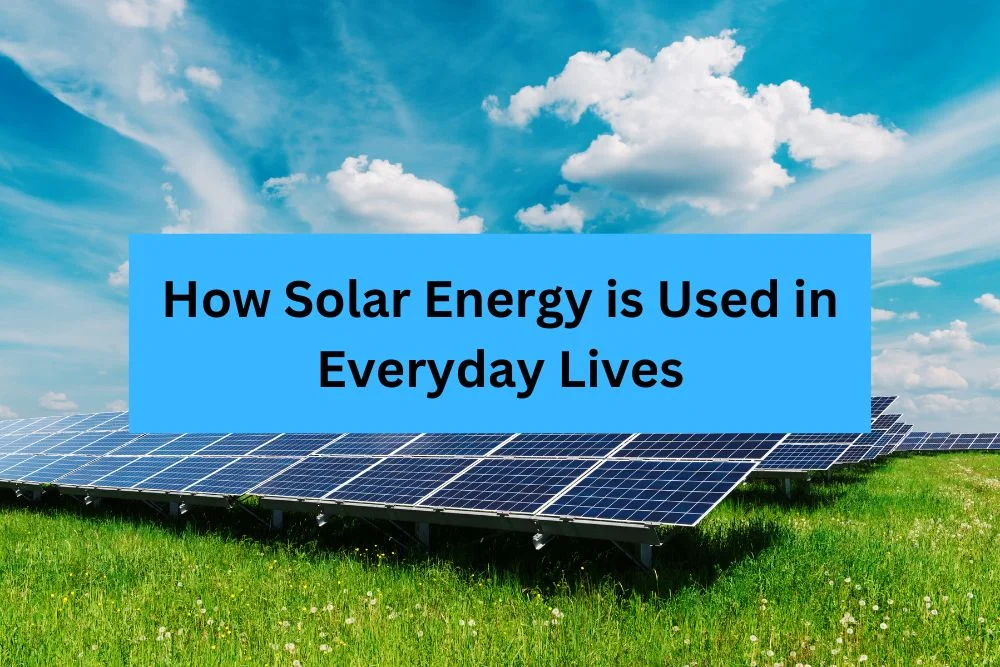Solar energy is not just an eco-friendly alternative; it’s a transformative and versatile energy source shaping our everyday routines and infrastructure. Today, we’ll exploreHow Solar Energy is Used in Everyday Lives. From powering homes and businesses to revolutionizing public spaces and transportation systems, solar technology offers a sustainable solution for diverse energy needs.
Harnessing Solar Power in Residential and Commercial Settings
1. Residential Solar Solutions
In many residential areas, solar panels have become a prominent fixture on rooftops, providing families with a renewable energy source that powers their daily activities. These systems, equipped with state-of-the-art solar inverters and batteries, harness sunlight and convert it into electricity used for lighting, heating, and operating home appliances. The adoption of residential solar energy is not only about harnessing a sustainable power source but also about enhancing energy independence. Households enjoy reduced utility bills and a significantly lower carbon footprint, making solar a financially and environmentally smart choice.
To illustrate, consider the case of a typical family in California that installed a solar panel system. Within a year, they observed a 60% reduction in their energy bills, and the increase in their property’s value was an added bonus. Such stories are becoming common as more families across the United States recognize the long-term benefits of solar energy.
2. Commercial Solar Applications
Commercial entities, from small businesses to large corporations, are increasingly adopting solar energy to power their operations. These setups range from rooftop panels on office buildings to large-scale solar farms that can power manufacturing plants.
By investing in solar technology, companies not only reduce their energy costs but also boost their public image as leaders in sustainability and corporate responsibility.
For instance, a manufacturing company in Michigan transitioned to solar energy and was able to cut its annual energy expenses by over 40%. Additionally, the move helped the company secure a green certification, which enhanced its marketability and appealed to environmentally conscious consumers.
3. Solar Heating: Comfort and Efficiency
Solar heating systems represent a practical application of solar technology that extends beyond electricity generation. By using solar energy to heat water and indoor spaces, these systems offer an efficient alternative to traditional heating methods.
In both residential and commercial settings, solar heating reduces dependence on non-renewable energy sources and can lead to substantial savings on heating costs.
For example, a community housing project in New York implemented a solar thermal system that serves over 100 apartments, demonstrating a reduction in heating costs by approximately 30% per unit while providing reliable and eco-friendly heating.
4. Solar Energy in Transportation
The transportation sector is undergoing a significant transformation with the integration of solar energy. Solar-powered vehicles, from cars to buses equipped with photovoltaic cells, are hitting the roads, reducing greenhouse gas emissions and diminishing our reliance on oil. The push towards solar-powered public transportation systems is not only environmentally advantageous but also economically beneficial in the long run.
A notable development is the introduction of solar-powered buses in cities like Denver, which have proven to be effective in cutting operational costs and reducing urban air pollution.
5. Public and Community-Based Solar Initiatives
Solar energy is increasingly important in powering public infrastructure, which includes applications ranging from solar streetlights to public charging stations for electric vehicles. These community-based initiatives are crucial for developing smarter, more sustainable urban environments that promote the use of clean energy.
One innovative example is the installation of solar-powered kiosks in public parks that allow visitors to charge their devices, access Wi-Fi, and learn about solar energy through interactive displays.
Expert Insights and Future Trends

According to industry experts, the adoption of solar energy has seen exponential growth over the past decade. A report from the Solar Energy Industries Association highlights that solar installations in the U.S. have increased by over 35% in the last two years alone. This trend is expected to continue as solar technology advances and becomes more cost-effective.
Conclusion
Solar energy is transforming today’s energy landscape with its vast applications beyond traditional electricity, providing both sustainability and economic benefits.
Adopting solar solutions helps people, businesses, and communities support a sustainable planet while gaining economic benefits from this energy source.
Residential solar systems provide sustainable energy, cut utility costs, boost energy independence, and increase property value.
Adopting solar energy can reduce costs, improve businesses’ sustainability image, and help secure green certifications
The transportation sector is incorporating solar energy through vehicles equipped with photovoltaic cells, including cars and buses.




Thank you for your sharing. I am worried that I lack creative ideas. It is your article that makes me full of hope. Thank you. But, I have a question, can you help me?
Thank you for your sharing. I am worried that I lack creative ideas. It is your article that makes me full of hope. Thank you. But, I have a question, can you help me?
Thank you for your sharing. I am worried that I lack creative ideas. It is your article that makes me full of hope. Thank you. But, I have a question, can you help me?
Эта статья для ознакомления предлагает читателям общее представление об актуальной теме. Мы стремимся представить ключевые факты и идеи, которые помогут читателям получить представление о предмете и решить, стоит ли углубляться в изучение.
Подробнее можно узнать тут – https://vyvod-iz-zapoya-1.ru/
Your article helped me a lot, is there any more related content? Thanks!
cjc 1295 ipamorelin flushing
References:
ipamorelin vs mk-677 reddit